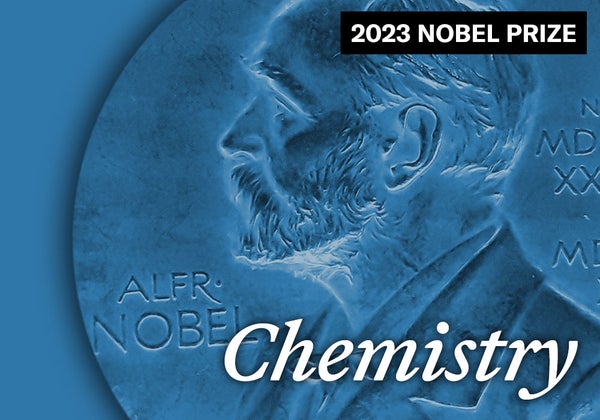The 2023 Nobel Prize in Chemistry was awarded today to three scientists for the discovery of quantum dots. These are nanoparticles so small that their size controls their many properties, such as their color. And that in turns makes them invaluable in applications ranging from large color displays to energy production.
The winners are Moungi Bawendi of the Massachusetts Institute of Technology, Louis Brus of Columbia University and Alexei Ekimov of the firm Nanocrystals Technology in New York State. The three scientists will share the prize of 11 million Swedish kronor, or nearly $1 million.
Producing a cornucopia of colors, quantum dots are common materials in big television screens today. Essentially they are tiny crystals, but it’s easier to think of each of them as a compressed ball, just a few nanometers in diameter, that contains electrons. The electrons are key to how the dots work. “If you take an electron and put it into a small space, its wave function gets compressed,” meaning the electron has less freedom to move, said Heiner Linke, a member of the Nobel Committee for Chemistry, at the announcement. The compression allows the electrons to store more energy.
On supporting science journalism
If you're enjoying this article, consider supporting our award-winning journalism by subscribing. By purchasing a subscription you are helping to ensure the future of impactful stories about the discoveries and ideas shaping our world today.
The electrons release that energy as photons—packets of light—and those photons will appear as different colors, depending on how much the electrons are squeezed.
That change is a quantum effect, one of the mysterious things that happens in the realm of the incredibly small. So, for example, the smallest dots will emit more shorter-wavelength blue light than longer-wavelength red light. Enlarging the dots slightly will change the color composition.
The dots are also used in biomedical imaging—to visualize blood vessels feeding tumors—and in solar cells, where they can amplify the energy generated by the panels. Changing their size can also change other properties, such as their melting point.
Bawendi, when reached by phone by the Royal Swedish Academy of Sciences after the announcement, said he was “very surprised..., sleepy, shocked ... and very honored.” The rest of the world may have been slightly less surprised. Bawendi’s name, along with his two colleagues, was leaked in a document sent out by the academy hours before the official announcement. It was a rare crack in what is ordinarily a highly organized and confidential process. Hans Ellegren, secretary-general of the academy, said the organization did not know what had happened.
The news, however it came out, was greeted with applause by other chemists. “These remarkable nanoparticles have huge potential to create smaller, faster, smarter devices, increasing the efficiency of solar panels and the brilliance of your TV screen,” said Gill Reid, president of the Royal Society of Chemistry and an inorganic chemist at the University of Southampton in England, in a recent statement. The Nobel “is really exciting and shows how chemistry can be used to solve a range of challenges,” she said.
And while quantum effects are often considered the province of physics, Judith Giordan, a chemist and president of the American Chemical Society, makes a strong case that dots are chemical products. “We own electrons. They’re on every single atom,” she says. And while the effects of confining electrons in tiny spaces were theorized by physicists, “it was chemists who moved them into novel architectures of atoms, who figured out how to actually produce them in the lab and then in manufacturing settings.”
The notion of quantum dots first showed up in theories in the 1930s and then stalled for decades. But in the early 1980s Ekimov put nanoparticles of copper chloride in glass and showed that the particle size changed the color of the glass through quantum effects. Several years later Brus achieved similar color alterations with nanoparticles floating freely in a fluid.
Bawendi, in 1993, developed a way to standardize dot production, which opened the field to many other labs and companies. “He made it easy,” says chemist Rigoberto Advincula, who works on nanoscale technology at the University of Tennessee, Knoxville. Bawendi’s lab created a kind of “soup” of other substances that attached to quantum dot seeds and precisely regulated their growth. This made the seeds very “tunable,” in chemistry lingo, Advincula says. It was a simple way to control their size and thus tune them to produce different levels of energy, he adds.
In addition to big screens and solar panels, dots are used to adjust the color of LED lights to make them less harsh. Medical scientists are also exploring their use as sensors and probes for hard-to-find molecules in the body. After the announcement, Bawendi said that “it’s just the beginning.”
